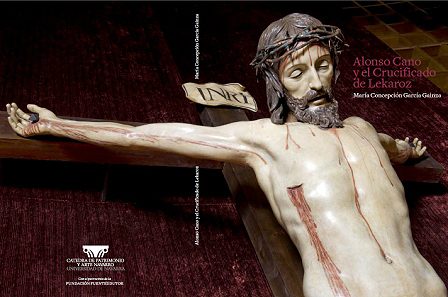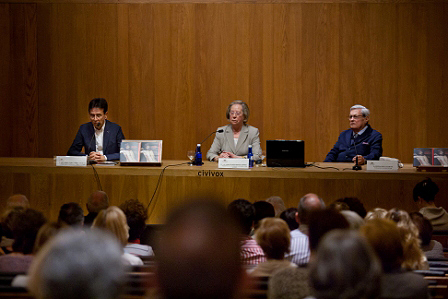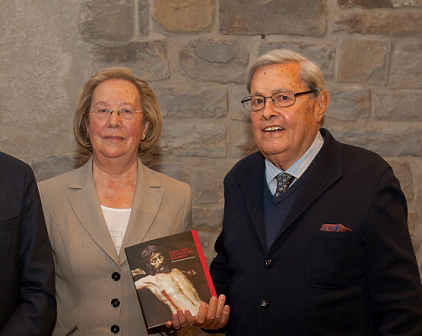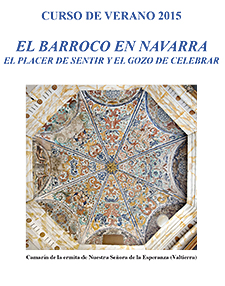THE BAROQUE IN NAVARRA. THE PLEASURE OF FEELING AND THE JOY OF CELEBRATING
September 15, 2015
presentation of the book: Alonso Cano and the Crucified of Lekaroz
Ms. Concepción García Gainza. Chair of Navarrese Heritage and Art.

Cover of the book presented
The Crucified of Lekaroz that today is venerated in the penitential chapel of the Capuchin church of San Antonio de Pamplona is a work of singular value from the gouges of Alonso Cano, one of the most outstanding masters of the Golden Age. The art of this Granada-born artist of a turbulent life who, after triumphing in the Court, became an ecclesiastic after the dramatic murder of his wife, as a canon of the cathedral of Granada, does not reveal the impetuousness of his genius. His art breathes balance and beauty. Artist of a high intellectual training judging by his extensive Library Services, restless in the search for sources of inspiration, he will seek above all "the line and grace of beautiful bodies," according to Wethey. A total artist, he was a painter, sculptor, perspective and excellent draughtsman.
The Crucified of Lekaroz due to such a distinguished artist was made by Alonso Cano for the Benedictine monastery of Montserrat in Madrid and was finished by the express wish of Queen Mariana of Austria. There it was seen by the scholars of the 18th century who refer to it with admiration as the "famous" Christ of Alonso Cano.
This book, sponsored by the Fuentes Dutor Foundation and edited by the Chair of Heritage and Navarrese Art of the University of Navarra, studies the intricate history that this Crucified Christ went through until its arrival at the recently founded high school of Lekaroz. Its two successive admissions in the Academy of San Fernando to protect it successively from the War of Independence and the Disentailment and finally its shipment to Lekaroz in 1891, whose receipt states that the donation is made "in perpetuity", that is to say, forever.
The Crucified of Lekaroz sample the originality of Cano in its composition as it does in other Christs of painting. In fact, it is a fused vision of sculpture and painting. Alonso Cano by means of proportion and mastery of the Anatomy manages to express deep religious feelings. The earthly beauty of Christ's body corresponds to the spiritual beauty. Beauty of the body, beauty of the soul. It is undoubtedly one of the most beautiful and masterful sculptures of the entire seventeenth century.
Professor María Concepción García Gainza, president of the Chair de Patrimonio y Arte Navarro, professor of Art History at the University of Murcia and the University of Navarra, where she is professor emeritus, is a corresponding member of the Royal Academy of Fine Arts of San Fernando and of the Academy of Santa Isabel de Hungría in Seville. Director of the Catalog Monumental de Navarra, her programs of study has focused mainly on Spanish and European Renaissance and Baroque art, as well as on the study of silverware. She has directed more than thirty doctoral thesis and numerous works of research.

Moment of the book presentation

The book, published by the Chair de Patrimonio y Arte Navarro, has been possible thanks to the sponsorship of the Fuentes Dutor Foundation, which was represented by Fernando Galbete.
PROGRAM
Tuesday, 15th September
The Baroque, an invention of the 20th century?
Javier Portús Pérez. Prado National Museum
Does the Baroque exist in Navarre?
D. Ricardo Fernández Gracia. Chair of Heritage and Art of Navarre
Wednesday, 16th September
"Plegaria de ladrillo y sillar" (Brick and ashlar prayer). Religious architecture in the Navarrese Baroque
Mr. José Javier Azanza López. Chair of Navarrese Heritage and Art
The construction of an image of power: town planning, houses and palaces.
Ms. Pilar Andueza Unanua. Chair of Navarrese Heritage and Art
Thursday, 17th September
Of chisel, hammer and paintbrush. The visual arts at the service of the Church and power
D. Ricardo Fernández Gracia. Chair of Navarrese Art and Heritage.
Jewellery and silver. Adornment and function
Mª Concepción García Gainza. Chair of Heritage and Art in Navarre
presentation of the book Alonso Cano and the Lekaroz Crucifixion
Mª Concepción García Gainza. Chair de Patrimonio y Arte navarro

